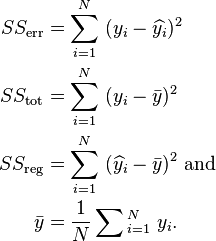Fraction of variance unexplained
In statistics, the fraction of variance unexplained (FVU) in the context of a regression task is the fraction of variance of the regressand (dependent variable) Y which cannot be explained, i.e., which is not correctly predicted, by the explanatory variables X.
For a more general concept, see explained variation.
Formal definition
Suppose we are given a regression function ƒ yielding for each yi, 1 ≤ i ≤ N, an estimate  where
where  is the vector of the ith observations on all the explanatory variables. We define the fraction of variance unexplained (FVU) as:
is the vector of the ith observations on all the explanatory variables. We define the fraction of variance unexplained (FVU) as:
where R2 is the coefficient of determination and VARerr and VARtot are the variance of the estimated residuals and the sample variance of the dependent variable. SSerr (the sum of squared predictions errors, equivalently the residual sum of squares), SStot (the total sum of squares), and SSreg (the sum of squares of the regression, equivalently the explained sum of squares) are given by
Alternatively, the fraction of variance unexplained can be defined as follows:
where MSE(f) is the mean squared error of the regression function ƒ.
Explanation
It is useful to consider the second definition to understand FVU. When trying to predict Y, the most naïve regression function that we can think of is the constant function predicting the mean of Y, i.e.,  . It follows that the MSE of this function equals the variance of Y; that is, SSerr = SStot, and SSreg = 0. In this case, no variation in Y can be accounted for, and the FVU then has its maximum value of 1.
. It follows that the MSE of this function equals the variance of Y; that is, SSerr = SStot, and SSreg = 0. In this case, no variation in Y can be accounted for, and the FVU then has its maximum value of 1.
More generally, the FVU will be 1 if the explanatory variables X tell us nothing about Y in the sense that the predicted values of Y do not covary with Y. But as prediction gets better and the MSE can be reduced, the FVU goes down. In the case of perfect prediction where  for all i, the MSE is 0, SSerr = 0, SSreg = SStot, and the FVU is 0.
for all i, the MSE is 0, SSerr = 0, SSreg = SStot, and the FVU is 0.
![\begin{align}
\text{FVU} & = {VAR_{\rm err} \over VAR_{\rm tot}} = {SS_{\rm err}/n \over SS_{\rm tot}/n} = {SS_{\rm err} \over SS_{\rm tot}} = 1-{SS_{\rm reg} \over SS_{\rm tot}} \\[6pt]
& = 1 - R^2,
\end{align}](../I/m/3ef01a8e0a82ba1165785e48df6cecaa.png)

![\text{FVU} = \frac{\text{MSE}(f)}{\text{var}[Y]},](../I/m/392f4b49460ff167c7716889a015c24b.png)